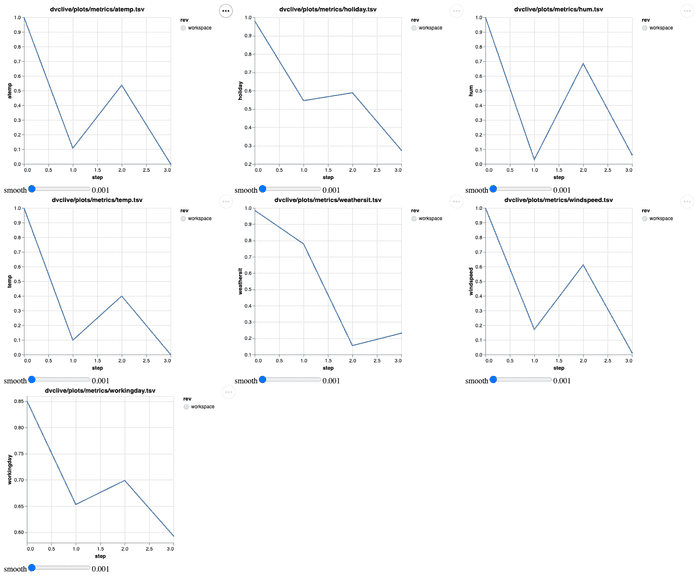在 GitHub 上编辑
Evidently
DVCLive 可用于跟踪 Evidently 的结果。接下来我们通过一个示例进行演示。
设置
$ pip install dvc dvclive evidently pandas加载数据
从 UCI 仓库加载数据 并保存到本地。为了演示目的,我们将这些数据视为实时模型的输入数据。在生产环境中使用时,您应确保能够访问您的预测日志。
$ wget https://archive.ics.uci.edu/static/public/275/bike+sharing+dataset.zip
$ unzip bike+sharing+dataset.zipimport pandas as pd
df = pd.read_csv("raw_data/day.csv", header=0, sep=',', parse_dates=['dteday'])
df.head()这就是它的样子: 
定义列映射
您应指定分类特征和数值特征,以便 Evidently 对每种类型执行正确的统计检验。虽然 Evidently 可以自动解析数据结构,但手动指定列类型可以最大限度地减少错误。
from evidently.pipeline.column_mapping import ColumnMapping
data_columns = ColumnMapping()
data_columns.numerical_features = ['weathersit', 'temp', 'atemp', 'hum', 'windspeed']
data_columns.categorical_features = ['holiday', 'workingday']定义要记录的内容
指定您希望计算的指标。在此案例中,您可以生成数据漂移报告,并记录每个特征的漂移分数。
from evidently.report import Report
from evidently.metric_preset import DataDriftPreset
def eval_drift(reference, production, column_mapping):
data_drift_report = Report(metrics=[DataDriftPreset()])
data_drift_report.run(
reference_data=reference, current_data=production, column_mapping=column_mapping
)
report = data_drift_report.as_dict()
drifts = []
for feature in (
column_mapping.numerical_features + column_mapping.categorical_features
):
drifts.append(
(
feature,
report["metrics"][1]["result"]["drift_by_columns"][feature][
"drift_score"
],
)
)
return drifts
您可以通过从 Evidently 提供的预设(Preset)或指标(Metric)中选择不同的选项,来调整需要计算的内容。
定义比较窗口
指定作为参考的时间段:Evidently 将以此作为比较基准。然后,您应选择作为实验处理的时间段。这模拟了生产模型的运行过程。
#set reference dates
reference_dates = ('2011-01-01 00:00:00','2011-01-28 23:00:00')
#set experiment batches dates
experiment_batches = [
('2011-01-01 00:00:00','2011-01-29 23:00:00'),
('2011-01-29 00:00:00','2011-02-07 23:00:00'),
('2011-02-07 00:00:00','2011-02-14 23:00:00'),
('2011-02-15 00:00:00','2011-02-21 23:00:00'),
]在 DVC 中运行并记录实验
有两种方式可以使用 DVCLive 跟踪 Evidently 的结果:
- 您可以将批次中每个项目的结果保存在一个单一实验中(每个实验对应一次 git 提交),分步骤保存
- 或者您可以将批次中每个项目的结果保存为独立的实验
我们将演示这两种方法,并向您展示如何在不依赖特定 IDE 的情况下检查结果。但是,如果您使用的是 VSCode,我们建议使用 VS Code 的 DVC 扩展 来查看结果。
1. 单一实验
from dvclive import Live
with Live() as live:
for date in experiment_batches:
live.log_param("begin", date[0])
live.log_param("end", date[1])
metrics = eval_drift(
df.loc[df.dteday.between(reference_dates[0], reference_dates[1])],
df.loc[df.dteday.between(date[0], date[1])],
column_mapping=data_columns,
)
for feature in metrics:
live.log_metric(feature[0], round(feature[1], 3))
live.next_step()然后您可以使用以下方式检查结果:
$ dvc plots show并检查生成的 dvc_plots/index.html,其外观应如下所示: 
在 Jupyter Notebook 环境中,只需使用 Live(report="notebook") 即可将图表作为单元格输出显示。
2. 多个实验
from dvclive import Live
for step, date in enumerate(experiment_batches):
with Live() as live:
live.log_param("begin", date[0])
live.log_param("end", date[1])
live.log_param("step", step)
metrics = eval_drift(
df.loc[df.dteday.between(reference_dates[0], reference_dates[1])],
df.loc[df.dteday.between(date[0], date[1])],
column_mapping=data_columns,
)
for feature in metrics:
live.log_metric(feature[0], round(feature[1], 3))
您可以使用以下方式检查结果:
$ dvc exp show────────────────────────────────────────────────────────────────────────────────────────────────────────────────────────────────────────────────────────────────
Experiment Created weathersit temp atemp hum windspeed holiday workingday step begin end
────────────────────────────────────────────────────────────────────────────────────────────────────────────────────────────────────────────────────────────────
workspace - 0.231 0 0 0.062 0.012 0.275 0.593 3 2011-02-15 00:00:00 2011-02-21 23:00:00
master 10:02 AM - - - - - - - - - -
├── a96b45c [muggy-rand] 10:02 AM 0.231 0 0 0.062 0.012 0.275 0.593 3 2011-02-15 00:00:00 2011-02-21 23:00:00
├── 78c6668 [pawky-arcs] 10:02 AM 0.155 0.399 0.537 0.684 0.611 0.588 0.699 2 2011-02-07 00:00:00 2011-02-14 23:00:00
├── c1dd720 [joint-wont] 10:02 AM 0.779 0.098 0.107 0.03 0.171 0.545 0.653 1 2011-01-29 00:00:00 2011-02-07 23:00:00
└── d0ddb8d [osmic-impi] 10:02 AM 0.985 1 1 1 1 0.98 0.851 0 2011-01-01 00:00:00 2011-01-29 23:00:00
────────────────────────────────────────────────────────────────────────────────────────────────────────────────────────────────────────────────────────────────在 Jupyter Notebook 环境中,您可以使用 Python DVC API 访问实验结果:
import dvc.api
dvc.api.exp_show()